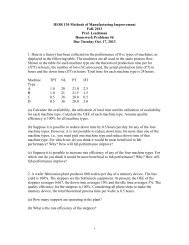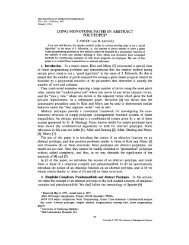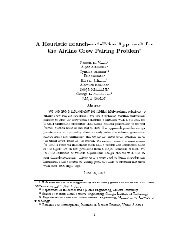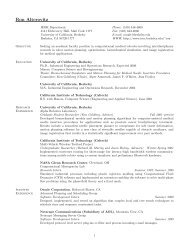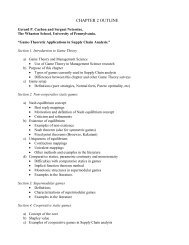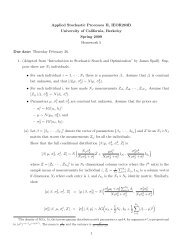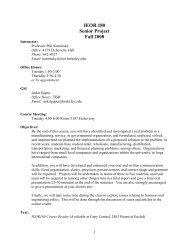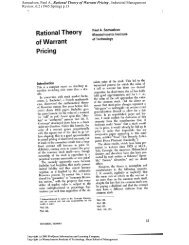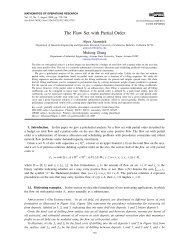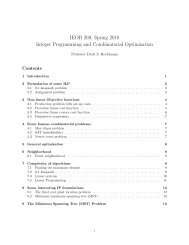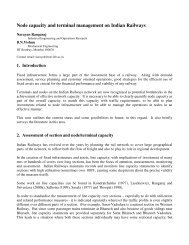A transmission-constrained unit commitment method in ... - CiteSeerX
A transmission-constrained unit commitment method in ... - CiteSeerX
A transmission-constrained unit commitment method in ... - CiteSeerX
You also want an ePaper? Increase the reach of your titles
YUMPU automatically turns print PDFs into web optimized ePapers that Google loves.
Ž .<br />
Decision Support Systems 24 1999 297–310<br />
A <strong>transmission</strong>-<strong>constra<strong>in</strong>ed</strong> <strong>unit</strong> <strong>commitment</strong> <strong>method</strong> <strong>in</strong> power<br />
system schedul<strong>in</strong>g<br />
Chung-Li Tseng a,) , Shmuel S. Oren a , Carol S. Cheng b , Chao-an Li b ,<br />
Alva J. Svoboda b , Raymond B. Johnson b<br />
a Department of Industrial Eng<strong>in</strong>eer<strong>in</strong>g Operations Research, UniÕersity of California, Berkeley, CA 94720, USA<br />
b Pacific Gas Electric Company, San Francisco, CA 94177, USA<br />
Abstract<br />
This paper presents a <strong>transmission</strong>-<strong>constra<strong>in</strong>ed</strong> <strong>unit</strong> <strong>commitment</strong> <strong>method</strong> us<strong>in</strong>g a Lagrangian relaxation approach. Based<br />
on a DC power flow model, the <strong>transmission</strong> constra<strong>in</strong>ts are formulated as l<strong>in</strong>ear constra<strong>in</strong>ts. The <strong>transmission</strong> constra<strong>in</strong>ts, as<br />
well as the demand and sp<strong>in</strong>n<strong>in</strong>g reserve constra<strong>in</strong>ts, are relaxed by attach<strong>in</strong>g Lagrange multipliers. A three-phase<br />
algorithmic scheme is devised <strong>in</strong>clud<strong>in</strong>g dual optimization, a feasibility phase and <strong>unit</strong> de<strong>commitment</strong>. A large-scale test<br />
problem with more than 2200 buses and 2500 <strong>transmission</strong> l<strong>in</strong>es is tested along with other test problems. q 1999 Elsevier<br />
Science B.V. All rights reserved.<br />
Keywords: Power system schedul<strong>in</strong>g; Unit <strong>commitment</strong>; Transmission-<strong>constra<strong>in</strong>ed</strong> <strong>unit</strong> <strong>commitment</strong>; Unit de<strong>commitment</strong><br />
1. Introduction<br />
The <strong>unit</strong> <strong>commitment</strong> is an optimization problem that economically schedules generat<strong>in</strong>g <strong>unit</strong>s over a<br />
short-term plann<strong>in</strong>g horizon subject to the satisfaction of demand and other system operat<strong>in</strong>g constra<strong>in</strong>ts. The<br />
<strong>unit</strong> <strong>commitment</strong> problem is considered to be <strong>in</strong> the class of NP-hard problems w14 x. Many optimization <strong>method</strong>s<br />
have been proposed to solve the <strong>unit</strong> <strong>commitment</strong> problem, e.g., see Ref. wx 4 for a survey. These <strong>method</strong>s<br />
<strong>in</strong>clude priority list <strong>method</strong>s wx 3 dynamic programm<strong>in</strong>g <strong>method</strong>s w10,11,18x sequential <strong>method</strong> wx 8 and Law2,4–6<br />
x, etc. Lagrangian relaxation <strong>method</strong>s are now among the most widely used<br />
grangian relaxation <strong>method</strong>s<br />
approaches to solv<strong>in</strong>g <strong>unit</strong> <strong>commitment</strong>.<br />
Because generat<strong>in</strong>g <strong>unit</strong>s of a utility company are normally located <strong>in</strong> different areas <strong>in</strong>terconnected via<br />
<strong>transmission</strong> l<strong>in</strong>es, power flows are subject to thermal limit of <strong>transmission</strong> l<strong>in</strong>es. However, the <strong>transmission</strong><br />
constra<strong>in</strong>ts were usually left out <strong>in</strong> the <strong>unit</strong> <strong>commitment</strong> problems. If the <strong>transmission</strong> constra<strong>in</strong>ts are not<br />
considered, the schedule obta<strong>in</strong>ed might cause some <strong>transmission</strong> l<strong>in</strong>es to be overloaded. This may result <strong>in</strong><br />
) Correspond<strong>in</strong>g author. Department of Civil Eng<strong>in</strong>eer<strong>in</strong>g, University of Maryland, College Park, MD 20742, USA. Tel.: q1-301-405-<br />
1341; fax: q1-301-405-2585; e-mail: chungli@eng.umd.edu<br />
0167-9236r99r$ - see front matter q 1999 Elsevier Science B.V. All rights reserved.<br />
Ž .<br />
PII: S0167-9236 98 00072-4
298<br />
( )<br />
C.-L. Tseng et al.rDecision Support Systems 24 1999 297–310<br />
reschedul<strong>in</strong>g of some generat<strong>in</strong>g <strong>unit</strong>s and may <strong>in</strong>cur significant costs. This paper presents a <strong>method</strong> for solv<strong>in</strong>g<br />
the <strong>unit</strong> <strong>commitment</strong> problem which takes <strong>transmission</strong> constra<strong>in</strong>ts <strong>in</strong>to account. A first attempt to <strong>in</strong>corporate<br />
AC load flow constra<strong>in</strong>ts <strong>in</strong> <strong>unit</strong> <strong>commitment</strong> optimization was detailed <strong>in</strong> Ref. wx 9 with promis<strong>in</strong>g although<br />
limited computational test<strong>in</strong>g. At present, the computational requirements of that approach would be prohibitive<br />
for practical size problems but that might change with the rapid development <strong>in</strong> computation technology.<br />
In this paper, the <strong>transmission</strong> constra<strong>in</strong>ts will be formulated as l<strong>in</strong>ear constra<strong>in</strong>ts based on a DC power flow<br />
model. Pang et al. have considered the <strong>transmission</strong> <strong>constra<strong>in</strong>ed</strong> <strong>unit</strong> <strong>commitment</strong> problem <strong>in</strong> Ref. w11x<br />
us<strong>in</strong>g a<br />
dynamic programm<strong>in</strong>g <strong>method</strong>. In Ref. w12 x, Shaw has proposed a practical <strong>method</strong> for solv<strong>in</strong>g the security-<strong>constra<strong>in</strong>ed</strong><br />
<strong>unit</strong> <strong>commitment</strong> problem us<strong>in</strong>g the Lagrangian relaxation approach. This approach relaxes not only the<br />
demand constra<strong>in</strong>ts and the sp<strong>in</strong>n<strong>in</strong>g reserve constra<strong>in</strong>ts, but also the <strong>transmission</strong> constra<strong>in</strong>ts us<strong>in</strong>g multipliers.<br />
Shaw describes two <strong>method</strong>s <strong>in</strong> his paper w12 x, a direct <strong>method</strong> and an <strong>in</strong>direct <strong>method</strong>. The former takes full<br />
account of the <strong>transmission</strong> constra<strong>in</strong>ts <strong>in</strong> the optimization phase, while the latter does so only <strong>in</strong> locat<strong>in</strong>g a<br />
feasible solution. The conclusion of Ref. w12x<br />
favors the direct <strong>method</strong>.<br />
In this paper, we employ a three-phase algorithmic scheme w14–16x<br />
to solve the <strong>unit</strong> <strong>commitment</strong> problem.<br />
The three phases <strong>in</strong>clude dual optimization, a feasibility phase and <strong>unit</strong> de<strong>commitment</strong>. Algorithmically, the<br />
dual optimization phases of most Lagrangian relaxation-based approaches are alike. These approaches differentiate<br />
<strong>in</strong> obta<strong>in</strong><strong>in</strong>g a feasible solution. In this paper we will present a robust feasibility <strong>method</strong> us<strong>in</strong>g l<strong>in</strong>ear<br />
programm<strong>in</strong>g. The obta<strong>in</strong>ed feasible schedule will then be improved by a <strong>unit</strong> de<strong>commitment</strong> <strong>method</strong>. It has<br />
been shown <strong>in</strong> Ref. w15x<br />
that <strong>unit</strong> de<strong>commitment</strong> not only improves solution quality generally, but also mitigates<br />
unpredictable effects due to heuristics <strong>in</strong> the first two phases. In this paper, we apply our <strong>method</strong> to a practical<br />
test problem, which <strong>in</strong>volves more than 2200 buses and 2500 <strong>transmission</strong> l<strong>in</strong>es, and other small-scale test<br />
problems as well.<br />
This paper is organized as follows: Section 2 gives the formulation of the <strong>unit</strong> <strong>commitment</strong> problem. A<br />
three-phase Lagrangian relaxation algorithm is presented <strong>in</strong> Section 3. Section 4 gives some numerical results.<br />
We conclude the paper <strong>in</strong> Section 5.<br />
2. Problem formulation<br />
We first def<strong>in</strong>e the follow<strong>in</strong>g nomenclature.<br />
t: Index for time Ž ts0, PPP , T .<br />
b: Index for the number of buses Ž bs1, PPP , B.<br />
L b:<br />
Index set of <strong>unit</strong>s at bus b<br />
i: Index for the number of <strong>unit</strong>s Ž igL , bs1, PPP , B.<br />
b<br />
l : Index for <strong>transmission</strong> l<strong>in</strong>es Ž ls1, PPP , L.<br />
G l b: L<strong>in</strong>e flow distribution factor for <strong>transmission</strong> l<strong>in</strong>e l due to the net <strong>in</strong>jection at bus<br />
b<br />
F l :<br />
The <strong>transmission</strong> capacity on the <strong>transmission</strong> l<strong>in</strong>e l<br />
u it:<br />
Zero-one decision variable <strong>in</strong>dicat<strong>in</strong>g whether <strong>unit</strong> i is up or down <strong>in</strong> time period<br />
t.<br />
x it:<br />
State variable <strong>in</strong>dicat<strong>in</strong>g the length of time that <strong>unit</strong> i has been up or down <strong>in</strong> time<br />
period t<br />
ti<br />
on :<br />
The m<strong>in</strong>imum number of periods <strong>unit</strong> i must rema<strong>in</strong> on after it has been turned on<br />
ti<br />
off :<br />
The m<strong>in</strong>imum number of periods <strong>unit</strong> i must rema<strong>in</strong> off after it has been turned<br />
off<br />
p it:<br />
Variable <strong>in</strong>dicat<strong>in</strong>g the amount of power <strong>unit</strong> i is generat<strong>in</strong>g <strong>in</strong> time period t<br />
pi<br />
m<strong>in</strong> :<br />
M<strong>in</strong>imum rated capacity of <strong>unit</strong> i<br />
p max :<br />
Maximum rated capacity of <strong>unit</strong> i<br />
i
( )<br />
C.-L. Tseng et al.rDecision Support Systems 24 1999 297–310 299<br />
C Ž p .<br />
i it : Fuel cost for operat<strong>in</strong>g <strong>unit</strong> i at output level pit<br />
<strong>in</strong> time period t<br />
S Ž x , u , u .<br />
i i,ty1 it i,ty1 : Start-up cost associated with turn<strong>in</strong>g on <strong>unit</strong> i at the beg<strong>in</strong>n<strong>in</strong>g of time period t<br />
D bt:<br />
Forecast demand requirement at bus b <strong>in</strong> time period t<br />
R bt:<br />
Sp<strong>in</strong>n<strong>in</strong>g capacity requirement at bus b <strong>in</strong> time period t<br />
The <strong>transmission</strong>-<strong>constra<strong>in</strong>ed</strong> <strong>unit</strong> <strong>commitment</strong> problem is formulated as the follow<strong>in</strong>g mixed-<strong>in</strong>teger<br />
programm<strong>in</strong>g problem: Žnote that the underl<strong>in</strong>ed variables are vectors <strong>in</strong> this paper, e.g. the components of u are<br />
all legitimate u .<br />
it .<br />
M<strong>in</strong>imize the total generat<strong>in</strong>g cost:<br />
T<br />
B<br />
Ý Ý Ý i it it i i,ty1 it i,ty1<br />
m<strong>in</strong> C Ž p . u qS Ž x , u , u . Ž 1.<br />
u,x, p ts1 bs1 igLb<br />
subject to the follow<strong>in</strong>g constra<strong>in</strong>ts:<br />
Demand constra<strong>in</strong>ts<br />
B<br />
Ý Ý Ý<br />
bs1 igLb<br />
B<br />
p u sD ' D , ;t, Ž 2.<br />
it it t bt<br />
bs1<br />
Sp<strong>in</strong>n<strong>in</strong>g capacity constra<strong>in</strong>ts<br />
B<br />
B<br />
max<br />
Ý Ý pi uitGR t' Ý R bt, ;t, 3<br />
bs1 igLb<br />
bs1<br />
Transmission constra<strong>in</strong>ts<br />
B<br />
Ý<br />
ž Ý /<br />
yF F G p u yD FF , ; l , t, Ž 4.<br />
l l b it it bt l<br />
bs1 igL b<br />
Local reserve constra<strong>in</strong>ts<br />
Ý it it bt bt bt<br />
igL b<br />
p u Gr D , r g w0,1 x,;b, Ž 5.<br />
max<br />
Ý p i u it Gs bt R bt , s bt g w0,1 x,;b, Ž 6.<br />
igL b<br />
where sbt<br />
and r bt are scalars used to def<strong>in</strong>e the local m<strong>in</strong>imum generation level and local sp<strong>in</strong>n<strong>in</strong>g capacity<br />
level with<strong>in</strong> bus b. Although constra<strong>in</strong>ts Ž. 5 and Ž. 6 are normally considered with<strong>in</strong> an area <strong>in</strong>stead of a bus, we<br />
<strong>in</strong>t to present a <strong>method</strong> suitable for a generalized multi-area model.<br />
Local <strong>unit</strong> constra<strong>in</strong>ts Unit capacity constra<strong>in</strong>ts, for all igL ;b and ts1,...,T:<br />
pi m<strong>in</strong> FpitFpi<br />
max , Ž 7.<br />
the state transition equations<br />
maxŽ x i ,ty1,0.<br />
q1, if uits1,<br />
x its Ž 8<br />
½<br />
.<br />
m<strong>in</strong>Ž x i ,ty1 ,0.<br />
y1, if u it s0,<br />
the m<strong>in</strong>imum uptime and downtime constra<strong>in</strong>ts,<br />
° 1, if 1Fx i ,ty1 -ti<br />
on ,<br />
u s~ off<br />
it 0, ify1Gx )yt ,<br />
Ž 9.<br />
i ,ty1 i<br />
¢ 0 or 1, otherwise,<br />
and the <strong>in</strong>itial conditions on x<br />
it<br />
at ts0 for ;i.<br />
b,<br />
Ž .
300<br />
( )<br />
C.-L. Tseng et al.rDecision Support Systems 24 1999 297–310<br />
For simplicity, we do not consider ramp constra<strong>in</strong>ts <strong>in</strong> this paper. Regard<strong>in</strong>g <strong>in</strong>corporat<strong>in</strong>g different k<strong>in</strong>ds of<br />
ramp constra<strong>in</strong>ts <strong>in</strong> the <strong>unit</strong> <strong>commitment</strong>, the <strong>in</strong>terested reader is directed to Refs. w13,14 x. If considered, the<br />
ramp constra<strong>in</strong>ts should be treated as are other local <strong>unit</strong> constra<strong>in</strong>ts such as Eq. Ž. 7 with<strong>in</strong> the correspond<strong>in</strong>g<br />
bus subproblem to be detailed later.<br />
3. Three-phase Lagrangian relaxation algorithm<br />
The Lagrangian relaxation Ž LR.<br />
approach relaxes the demand constra<strong>in</strong>ts, the sp<strong>in</strong>n<strong>in</strong>g reserve constra<strong>in</strong>ts<br />
and the <strong>transmission</strong> constra<strong>in</strong>ts us<strong>in</strong>g Lagrange multipliers. Algorithmically, the dual optimization of most<br />
Lagrangian relaxation based approaches are alike. The dual approach presented <strong>in</strong> this closely corresponds to the<br />
it direct <strong>method</strong> <strong>in</strong> Ref. w12 x.<br />
3.1. Phase 1: the dual optimization<br />
Lett<strong>in</strong>g l , m be the correspond<strong>in</strong>g nonnegative Lagrange multiplier of Eqs. Ž. 2 and Ž.<br />
t t<br />
3 , respectively. And<br />
a , b are correspond<strong>in</strong>g to Eq. Ž. 4 , n and r to Eqs. Ž. 5 and Ž.<br />
tl tl bt bt<br />
6 , respectively. We now have the follow<strong>in</strong>g<br />
dual problem:<br />
Ž D. max d l,m,a,b,n,r Ž 10.<br />
where<br />
Ž l,m,a,b,n,r.<br />
G0<br />
dŽ l,m,a,b,n,r.<br />
T<br />
B<br />
Ž .<br />
ÝÝ Ý i it it i i,ty1 it i,ty1<br />
' m<strong>in</strong> C Ž p . u qS Ž x , u , u .<br />
u it, x it, pit ts1 bs1 igL b<br />
ž / ž /<br />
ž / ž /<br />
max<br />
ž / ž /<br />
T B<br />
max<br />
y ÝÝ lt Ý pituityDbt qmt Ý pi uityR<br />
bt<br />
ts1 bs1 igLb<br />
igLb<br />
ž / ž /<br />
T L B B<br />
ÝÝ Ý Ý Ý Ý<br />
y a F q G p u yD qb F y G p u yD<br />
t l l l b it it bt t l l l b it it bt<br />
ts1 ls1 bs1 igLb bs1 igLb<br />
T<br />
B<br />
ÝÝ Ý Ý<br />
y n p u yr D qr p u ys R Ž 11.<br />
bt it it bt bt bt i it bt bt<br />
ts1 bs1 igLb<br />
igLb<br />
subject to <strong>in</strong>itial conditions, and the <strong>unit</strong> constra<strong>in</strong>ts. After rearrangement of the terms <strong>in</strong> Eq. Ž 11 ., the<br />
separability of dŽ l, m, a, b, n, r.<br />
appears.<br />
where<br />
B<br />
Ž . Ý Ý i Ž . Ž .<br />
d l,m,a,b,n,r s d b;l,m,a,b,n,r qs l,m,a,b,n,r , Ž 12.<br />
bs1 igL b<br />
ž / ž /<br />
T T L B B<br />
Ž . Ý Ý Ý Ý Ý<br />
s l,m,a,b,n,r s Ž l D qm R . y a F y G D qb F q G D<br />
t t t t t l l b l bt t l l b l bt<br />
ts1 ts1 ls1<br />
bs1 bs1<br />
T B<br />
ÝÝ bt bt bt bt bt bt<br />
ts1 bs1<br />
q Ž n r D qr s R . Ž 13.
is a constant term given the multipliers, and<br />
Ž . Ý<br />
( )<br />
C.-L. Tseng et al.rDecision Support Systems 24 1999 297–310 301<br />
T<br />
d b;l,m,a,b,n,r s m<strong>in</strong> c Ž p . qS Ž x , u , u . yl p ym p max<br />
i i it i i,ty1 it i,ty1 t it t i<br />
u it, x it, pit ts1<br />
L<br />
max<br />
Ý t l t l l b it bt it bt i it<br />
ls1<br />
y Ž a yb . G p yn p yr p u . Ž 14.<br />
Once aga<strong>in</strong>, the m<strong>in</strong>imization <strong>in</strong> Eq. Ž 14.<br />
is subject to <strong>in</strong>itial conditions and the <strong>unit</strong> constra<strong>in</strong>ts.<br />
Note that di<br />
is a <strong>unit</strong> subproblem correspond<strong>in</strong>g to <strong>unit</strong> i. We can further def<strong>in</strong>e a bus subproblem db<br />
such<br />
that<br />
d l,m,a,b,n,r ' d b;l,m,a,b,n,r Ž 15.<br />
b<br />
Ž . Ý iŽ .<br />
igL b<br />
Ž .<br />
and the dual objective 12 is equivalent to<br />
B<br />
Ž . Ý b Ž . Ž .<br />
d l,m,a,b,n,r s d l,m,a,b,n,r qs l,m,a,b,n,r Ž 16.<br />
bs1<br />
Each <strong>unit</strong> subproblem d ŽEq. Ž 14.. can be solved us<strong>in</strong>g dynamic programm<strong>in</strong>g. The dual function dŽ<br />
i<br />
l, m, a,<br />
b, n, r. is concave, but not necessarily differentiable at all po<strong>in</strong>ts Že.g. Ref. wx. 1 . A subgradient <strong>method</strong> is<br />
employed to solve the dual maximization problem Ž D ..<br />
A subgradient of the dual function d is an ascent direction of d. Let g be a po<strong>in</strong>t <strong>in</strong> the dual space, i.e. a<br />
vector of all multipliers, an iterative relation can be implemented to maximize the dual function d:<br />
g kq1 §g k qs k D g k , Ž 17.<br />
where the superscript denotes iteration k, s is the step size and Dg is a subgradient. The subgradient Dg k used<br />
here is a vector of the mismatches of the relaxed constra<strong>in</strong>ts evaluated at g k<br />
Žwx. 1 . The step size used <strong>in</strong> our<br />
implementation has the follow<strong>in</strong>g form,<br />
k<br />
s sm r5 g k<br />
5, m )0, Ž 18.<br />
k<br />
k<br />
where mk<br />
is an adaptive constant. Our stopp<strong>in</strong>g criteria used <strong>in</strong> the algorithm comb<strong>in</strong>e the maximum number of<br />
iteration, the change of norm of subgradients at two consecutive iterations and the number of iterations without<br />
improvement <strong>in</strong> the dual objective value. For details of the dual optimization algorithm, the reader is referred to<br />
Ref. w16 x.<br />
3.2. Phase 2: the feasibility phase<br />
Due to separability, the dual problem presented <strong>in</strong> the previous can be efficiently solved. Unfortunately,<br />
solv<strong>in</strong>g the dual problem is not necessarily equivalent to solv<strong>in</strong>g the primal orig<strong>in</strong>al problem. This can be seen<br />
<strong>in</strong> a fact that the solution obta<strong>in</strong>ed through the dual optimization of the <strong>unit</strong> <strong>commitment</strong> is generally not<br />
feasible. A feasibility phase is therefore required to obta<strong>in</strong> a feasible solution.<br />
Def<strong>in</strong>ition 1 With respect to a given sp<strong>in</strong>n<strong>in</strong>g capacity requirement R 4<br />
t ,areserÕe-feasible <strong>commitment</strong> is a<br />
<strong>unit</strong> <strong>commitment</strong> u<br />
4 that satisfies the sp<strong>in</strong>n<strong>in</strong>g reserve capacity constra<strong>in</strong>ts Ž.Ž. 2 , 6 , <strong>unit</strong> constra<strong>in</strong>ts Ž.Ž.<br />
it<br />
8 , 9 and<br />
the <strong>in</strong>itial conditions x i0.<br />
Def<strong>in</strong>ition 2 With respect to a given load requirement D 4, a <strong>unit</strong> <strong>commitment</strong> u<br />
4<br />
t<br />
it is said to be dispatchable if<br />
there exists a set of dispatches p 4 such that Eqs. Ž.Ž.Ž. 2 , 4 , 5 and Ž.<br />
it<br />
7 can be satisfied.B<br />
In Ref. w19 x, a <strong>method</strong> for obta<strong>in</strong><strong>in</strong>g feasible solutions to the s<strong>in</strong>gle-area <strong>unit</strong> <strong>commitment</strong> problem is<br />
proposed. The basic idea is to obta<strong>in</strong> a reserve-feasible <strong>commitment</strong> <strong>in</strong> the s<strong>in</strong>gle-area case, ignore Eq. Ž. 6 <strong>in</strong> the<br />
def<strong>in</strong>ition. In Ref. w19x<br />
a reserve-feasible <strong>commitment</strong> is found by project<strong>in</strong>g the subgradient onto the hour
302<br />
( )<br />
C.-L. Tseng et al.rDecision Support Systems 24 1999 297–310<br />
correspond<strong>in</strong>g to the most unsatisfied capacity constra<strong>in</strong>t and <strong>in</strong>creas<strong>in</strong>g only the multiplier mt<br />
of this hour. This<br />
approach can be modified to simultaneously updat<strong>in</strong>g the multipliers m t’s of it all hours that the sp<strong>in</strong>n<strong>in</strong>g<br />
capacity requirement is violated. Such a modification can speed up the feasibility phase at the cost of<br />
over<strong>commitment</strong> w5,14 x. Under the three-phase scheme, this over<strong>commitment</strong> effect can nevertheless be<br />
corrected <strong>in</strong> the f<strong>in</strong>al <strong>unit</strong> de<strong>commitment</strong> phase to be addressed <strong>in</strong> a later section.<br />
The feasibility phase presented <strong>in</strong> this paper conta<strong>in</strong>s two parts. Part 1 seeks a reserve-feasible <strong>commitment</strong><br />
by <strong>in</strong>creas<strong>in</strong>g the multipliers mt<br />
of all hours with <strong>in</strong>sufficient sp<strong>in</strong>n<strong>in</strong>g capacities. Start<strong>in</strong>g from this reserve-<br />
feasible <strong>commitment</strong> obta<strong>in</strong>ed, Part 2 solves a l<strong>in</strong>ear program Ž LP.<br />
for each hour to verify if this <strong>commitment</strong> is<br />
also dispatchable at this hour. If not, <strong>in</strong>formation can be extracted from the solution of the LP to determ<strong>in</strong>e how<br />
much additional sp<strong>in</strong>n<strong>in</strong>g capacity at this hour is required so that a dispatchable <strong>commitment</strong> exists. The<br />
sp<strong>in</strong>n<strong>in</strong>g reserve requirement of this hour is thus uplift. Part 1 is then rerun with respect to the new Ž uplift.<br />
sp<strong>in</strong>n<strong>in</strong>g reserve requirements. Suppose Part 1 of the feasibility phase term<strong>in</strong>ates at iteration k with an obta<strong>in</strong>ed<br />
<strong>commitment</strong> u k<br />
4<br />
it . Let qbt<br />
be the variable represent<strong>in</strong>g the total generation to be dispatched to bus b <strong>in</strong> time t.<br />
k<br />
4<br />
m<strong>in</strong> m<strong>in</strong> k max max k<br />
Given a <strong>commitment</strong> uit let qbt sÝig L pi uit and qbt sÝig L pi u it, which form an immediate<br />
b<br />
b<br />
lower bound and upper bound for q bt.<br />
ŽLPŽ t..<br />
Ž .<br />
m<strong>in</strong> Ý B y yq max Ž 19.<br />
q bt, ybt<br />
bs1 bt bt<br />
s.t. qbt m<strong>in</strong> FqbtFy bt, ;b Ž 20a.<br />
q max Fy FÝ p max , ;b Ž 20b.<br />
bt bt ig L b i<br />
Ýbs1 B qbtsDt<br />
Ž 20c.<br />
yFlFÝbs1 B G l bŽ qbtyDbt. FF l , ; l Ž 20d.<br />
q Gr D , ;b Ž 20e.<br />
bt bt bt<br />
Ž Ž ..<br />
max<br />
In LP t , y is a variable upper bound of both q and q . Let y ) be the solution of ŽLPŽ t ...Ifu k<br />
4<br />
bt bt bt bt it is<br />
max<br />
dispatchable <strong>in</strong> time t, y )sq solves ŽLPŽ t.. and the optimal objective value of ŽLPŽ t.. is zero. If u k<br />
4<br />
bt bt it is<br />
not dispatchable <strong>in</strong> time t, ŽLPŽ t..<br />
yields a positive objective value, which <strong>in</strong>dicates that to be dispatchable,<br />
more <strong>unit</strong>s should be committed <strong>in</strong> time t, and the target value of the new bus capacity requirement is now<br />
<strong>in</strong>creased to y bt) for each bus b <strong>in</strong> time t. That is, an additional bus sp<strong>in</strong>n<strong>in</strong>g capacity requirement is imposed<br />
to each bus subproblem d Ž P .:<br />
Ý i it bt<br />
b<br />
p max u Gy ). Ž 21.<br />
igL b<br />
Ž .<br />
Part 1 of the feasibility phase is therefore rerun with respect to the updated capacity requirement 21 . The phase<br />
2 algorithm is summarized below.<br />
3.2.1. Phase 2 algorithm<br />
Step 0: k§0; m 0 and r 0 and other multipliers are from Phase 1.<br />
k k<br />
Ž . Ž k k .<br />
Step 1: Given m and r and other multipliers, solve the dual subproblems 14 to obta<strong>in</strong> u , p .<br />
Ž. Ž.<br />
Step 2: If 3 and 6 are satisfied, go to Step 5 if Step 5 has not been visited, otherwise stop.<br />
kq1 k k<br />
Ž<br />
B max k<br />
.<br />
kq1 k k<br />
Step 3: For ;b,t, m §m qs Pm<strong>in</strong> 0, R yÝ Ý p u ; r §r qs Pm<strong>in</strong>Ž<br />
t t t bs1 i g L i it bt bt 0,sbtRbty<br />
b<br />
max<br />
Ý p u k<br />
..<br />
i g L b i it
Step 4: k§kq1, go to Step 1.<br />
( )<br />
C.-L. Tseng et al.rDecision Support Systems 24 1999 297–310 303<br />
k<br />
Step 5: Solve ŽLPŽ t.. for all t. If the optimal value of ŽLPŽ t.. is 0 for all t, stop and u is reserve-feasible and<br />
dispatchable. Otherwise, commit more <strong>unit</strong>s <strong>in</strong> any bus b and time t such that y bt))qbt<br />
max to satisfy Eq.<br />
Ž 21 ., where y ) solves ŽLPŽ t ..<br />
bt<br />
.<br />
In the algorithm, the loop between Step 1 and Step 4 corresponds to the Part 1 of the feasibility phase, and<br />
Step 5 corresponds to Part 2.<br />
The feasibility phase is nevertheless heuristic. An important issue is how robust the feasibility phase of a<br />
<strong>transmission</strong>-<strong>constra<strong>in</strong>ed</strong> <strong>unit</strong> <strong>commitment</strong> <strong>method</strong> is. To test the robustness of the feasibility phase, one can<br />
apply it to an <strong>in</strong>stance <strong>in</strong> which each s<strong>in</strong>gle bus has enough capacity to handle its own load over the plann<strong>in</strong>g<br />
horizon. Then the <strong>transmission</strong> l<strong>in</strong>e capacities are gradually reduced to zero. In such a problem, a feasible<br />
solution obviously exists, and it is equivalent to solv<strong>in</strong>g many s<strong>in</strong>gle-area <strong>unit</strong> <strong>commitment</strong> problems. It can be<br />
easily verified that our feasibility phase reduces to solv<strong>in</strong>g many s<strong>in</strong>gle-area problems <strong>in</strong> such an <strong>in</strong>stance.<br />
3.3. Economic dispatch<br />
With the DC power flow model, the <strong>transmission</strong> constra<strong>in</strong>ts are formulated as l<strong>in</strong>ear constra<strong>in</strong>ts. If the fuel<br />
cost is represented by a quadratic function of the power generation, the <strong>transmission</strong>-<strong>constra<strong>in</strong>ed</strong> economic<br />
dispatch is a quadratic programm<strong>in</strong>g problem. Many <strong>method</strong>s can be used to solve this type of problem, e.g., the<br />
reduced gradient <strong>method</strong>. In our implementation, the <strong>transmission</strong>-<strong>constra<strong>in</strong>ed</strong> economic dispatch is solved by<br />
the commercial software MINOS, which does general nonl<strong>in</strong>ear programm<strong>in</strong>g.<br />
3.4. Phase 3: <strong>unit</strong> de<strong>commitment</strong><br />
A Ž s<strong>in</strong>gle area. <strong>unit</strong> de<strong>commitment</strong> Ž UD. <strong>method</strong> was developed as a postprocess<strong>in</strong>g <strong>method</strong> for the Ž LR.<br />
approach for solv<strong>in</strong>g the <strong>unit</strong> <strong>commitment</strong> problem <strong>in</strong> Ref. w15 x. Given the demand requirement D t, reserve<br />
requirement R and a feasible solution Ž u, p. Ž satisfy<strong>in</strong>g D, R and all physical constra<strong>in</strong>ts .<br />
t ˜ ˜<br />
t t<br />
, the <strong>unit</strong><br />
de<strong>commitment</strong> <strong>method</strong> improves Ž u, ˜ p˜.<br />
while ma<strong>in</strong>ta<strong>in</strong><strong>in</strong>g feasibility. Thus, the <strong>unit</strong> de<strong>commitment</strong> can be<br />
regarded as a primal approach. A <strong>transmission</strong>-<strong>constra<strong>in</strong>ed</strong> <strong>unit</strong> de<strong>commitment</strong> algorithm can be devised by<br />
repeatedly solv<strong>in</strong>g the Ž s<strong>in</strong>gle area.<br />
<strong>unit</strong> de<strong>commitment</strong> to each bus. Suppose at iteration k, we have a feasible<br />
schedule Žu, ˜<br />
k p ˜<br />
k .. The schedule of bus b can be improved by the <strong>unit</strong> de<strong>commitment</strong> with respect to the it<br />
current load assigned to be the bus demand at this iteration, i.e., Ýi g L p˜it k u˜it<br />
k . The <strong>unit</strong> de<strong>commitment</strong> <strong>method</strong><br />
b<br />
can obta<strong>in</strong> a more efficient schedule, if possible, which generates the same load Ýi g L p˜it k u˜it<br />
k . After the<br />
b<br />
<strong>commitment</strong>s of all buses are ref<strong>in</strong>ed, a <strong>transmission</strong>-<strong>constra<strong>in</strong>ed</strong> economic dispatch is performed to redispatch<br />
the <strong>unit</strong>s <strong>in</strong> all buses. The de<strong>commitment</strong> procedure can thus proceed until no improvement <strong>in</strong> the total cost is<br />
made. S<strong>in</strong>ce at each iteration the de<strong>commitment</strong> procedure improves the <strong>commitment</strong> without affect<strong>in</strong>g the<br />
aggregated bus generation, the <strong>transmission</strong> feasibility is reta<strong>in</strong>ed at each iteration. The algorithm is as follows.<br />
3.4.1. Transmission-<strong>constra<strong>in</strong>ed</strong> UD algorithm<br />
Step 0: A feasible schedule Žu ˜<br />
0 , p˜<br />
k . is given, k§0.<br />
Step 1: Given Žu,p<br />
˜<br />
k ˜<br />
k . each bus performs the <strong>unit</strong> de<strong>commitment</strong> presented <strong>in</strong> Ref. w15x<br />
<strong>in</strong>dependently with<br />
the current load assigned to be the demand requirement Ýi g L p˜it k u˜it<br />
k also subject to the satisfaction of Eq.<br />
b<br />
k<br />
Ž. 6 . The resultant <strong>commitment</strong> is denoted by u ˆ .<br />
Step 2: Apply the <strong>transmission</strong>-<strong>constra<strong>in</strong>ed</strong> economic dispatch with respect to uˆ<br />
k to obta<strong>in</strong> a dispatch pˆ<br />
k . Let<br />
Žu ˜ kq1 , p ˜ kq1 .§ Žu,p ˜ k ˜<br />
k ..
304<br />
( )<br />
C.-L. Tseng et al.rDecision Support Systems 24 1999 297–310<br />
Step 3: If the total cost of Žu ˜ kq1 , p˜ kq1 . is no better than that of Žu,p ˜ k ˜<br />
k ., stop; otherwise k§kq1, and go to<br />
Step 1.<br />
The above <strong>method</strong> works best for the cases with many generators <strong>in</strong> each bus. For other <strong>transmission</strong>-conw14<br />
x.<br />
stra<strong>in</strong>ed <strong>unit</strong> de<strong>commitment</strong> approaches, the <strong>in</strong>terested reader is referred to Ref. 4. Numerical results<br />
The <strong>transmission</strong>-<strong>constra<strong>in</strong>ed</strong> <strong>unit</strong> <strong>commitment</strong> algorithm presented <strong>in</strong> this paper has been implemented <strong>in</strong><br />
FORTRAN on an HP 700 workstation. This presents numerical results of some test problems.<br />
Table 1<br />
Generat<strong>in</strong>g <strong>unit</strong> parameters<br />
a m<strong>in</strong> max up down cold<br />
b_i Type pi pi xi0 ti ti ti ai0 ai1 ai2 Si<br />
1_1 C 4 20 1 1 1 2 63.999 20.000 1.000=10 40<br />
y6<br />
1_2 C 4 20 2 1 1 2 63.999 20.000 1.000=10 40<br />
y2<br />
1_3 S2 10 76 3 6 6 12 133.919 16.193 1.508=10 45<br />
y2<br />
1_4 S2 10 76 y2 6 6 12 133.919 16.193 1.508=10 45<br />
y6<br />
2_1 C 4 20 1 1 1 2 63.999 20.000 1.000=10 40<br />
y6<br />
2_2 C 4 20 2 1 1 2 63.999 20.000 1.000=10 40<br />
y2<br />
2_3 S2 10 76 10 6 6 12 133.919 16.193 1.508=10 45<br />
y2<br />
2_4 S2 10 76 y2 6 6 12 133.919 16.193 1.508=10 45<br />
y2<br />
7_1 S1 15 100 10 10 10 20 199.124 12.468 1.532=10 45<br />
y2<br />
7_2 S1 15 100 10 10 10 20 199.124 12.468 1.532=10 110<br />
y2<br />
7_3 S1 15 100 10 10 10 20 199.124 12.468 1.532=10 110<br />
y3<br />
13_1 S1 20 197 12 12 12 24 209.546 13.928 2.085=10 100<br />
y3<br />
13_2 S1 20 197 12 12 12 24 209.546 13.928 2.085=10 100<br />
13_3 S1 20 197 12 12 12 24 209.546 13.928<br />
y3<br />
2.085=10 100<br />
15_1 S1 3 12 4 2 2 4 21.145 16.193 9.553=10 y2 30<br />
y2<br />
15_2 S2 3 12 y9 2 2 4 21.145 16.193 9.553=10 30<br />
y2<br />
15_3 S1 3 12 4 2 2 4 21.145 16.193 9.553=10 30<br />
y2<br />
15_4 S1 3 12 3 2 2 4 21.145 16.193 9.553=10 30<br />
y2<br />
15_5 S1 3 12 4 2 2 4 21.145 16.193 9.553=10 30<br />
y3<br />
15_6 S2 20 155 y20 12 12 24 275.606 12.360 8.898=10 100<br />
y3<br />
16_1 S2 20 155 5 12 12 24 275.606 12.360 8.898=10 100<br />
y4<br />
18_1 S3 40 400 100 48 48 60 577.537 14.253 7.365=10 440<br />
y4<br />
21_1 S3 40 400 100 48 48 60 577.537 14.253 7.365=10 440<br />
y2<br />
22_1 S2 10 76 y2 6 6 12 133.919 16.193 1.508=10 45<br />
y2<br />
22_2 S2 10 76 y2 6 6 12 133.919 16.193 1.508=10 45<br />
y2<br />
22_3 S2 10 76 y2 6 6 12 133.919 16.193 1.508=10 45<br />
y2<br />
22_4 S2 10 76 y2 6 6 12 133.919 16.193 1.508=10 45<br />
y2<br />
22_5 S2 10 76 y2 6 6 12 133.919 16.193 1.508=10 45<br />
22_6 S2 10 76 y2 6 6 12 133.919 16.193<br />
y2<br />
1.508=10 45<br />
23_1 S2 20 155 5 12 12 24 275.606 12.360 8.898=10 y3 100<br />
23_2 S2 20 155 3 12 12 24 275.606 12.360<br />
y3<br />
8.898=10 100<br />
23_3 S2 35 350 11 24 24 36 517.669 11.892<br />
y3<br />
5.220=10 250<br />
a S1: Steam: fossil-oil; S2: Steam: fossil-coal; S3: Steam: nuclear; C: Combustion turb<strong>in</strong>e.<br />
y6
( )<br />
C.-L. Tseng et al.rDecision Support Systems 24 1999 297–310 305<br />
4.1. IEEE test system<br />
The first test problem is based on an IEEE test problem wx 7 . This test system conta<strong>in</strong>s 24 buses, 34<br />
<strong>transmission</strong> l<strong>in</strong>es and 32 generat<strong>in</strong>g <strong>unit</strong>s. The parameters of the generat<strong>in</strong>g <strong>unit</strong>s are summarized <strong>in</strong> Table 1, <strong>in</strong><br />
which the <strong>unit</strong> fuel costs are assume to be a quadratic function of power generation as:<br />
CiŽ pit. sai0 qai1 pitqai2 pit<br />
2 , Ž 22.<br />
and the <strong>unit</strong> startup costs S are assumed to be constants. This test system conta<strong>in</strong>s steam <strong>unit</strong>s and combustion<br />
i<br />
turb<strong>in</strong>es as <strong>in</strong>dicated <strong>in</strong> Table 1.<br />
The <strong>transmission</strong> l<strong>in</strong>e parameters are given <strong>in</strong> Table 2. In Table 2 two sets of l<strong>in</strong>e capacities are presented.<br />
The capacities of the first set of <strong>transmission</strong> l<strong>in</strong>es are generally larger than those of the second set. Therefore,<br />
the second set of <strong>transmission</strong> l<strong>in</strong>es would yield more serious congestion than the first set. A 24-h plann<strong>in</strong>g<br />
horizon is adopted <strong>in</strong> the test problem, the system load <strong>in</strong>formation can be found <strong>in</strong> Table 3. The load taken here<br />
corresponds to the day with peak load <strong>in</strong> the year <strong>in</strong> the IEEE test problem. In this test, the sp<strong>in</strong>n<strong>in</strong>g capacity<br />
Table 2<br />
Transmission l<strong>in</strong>e parameters<br />
l From bus To bus X Ž p.u. . Ž i. Fl<br />
Ž MW. Ž ii. Fl<br />
Ž MW.<br />
1 1 2 0.0139 175 175<br />
2 1 3 0.2112 175 175<br />
3 1 5 0.0845 175 175<br />
4 2 4 0.1267 175 175<br />
5 2 6 0.1920 175 175<br />
6 3 9 0.1190 175 175<br />
7 3 24 0.0839 400 175<br />
8 4 9 0.1037 175 175<br />
9 5 10 0.0883 175 175<br />
10 6 10 0.0605 175 175<br />
11 7 8 0.0614 175 175<br />
12 8 9 0.1651 175 175<br />
13 8 10 0.1651 175 175<br />
14 9 11 0.0839 400 175<br />
15 9 12 0.0839 400 136<br />
16 10 11 0.0839 400 200<br />
17 10 12 0.0839 400 250<br />
18 11 13 0.0476 400 198<br />
19 11 14 0.0418 400 250<br />
20 12 13 0.0476 400 150<br />
21 12 23 0.0966 400 166<br />
22 13 23 0.0865 400 250<br />
23 14 16 0.0389 400 220<br />
24 15 16 0.0173 400 250<br />
25 15 21 0.0245 400 290<br />
26 15 24 0.0519 400 270<br />
27 16 17 0.0259 400 270<br />
28 16 19 0.0231 400 270<br />
29 17 18 0.0144 400 270<br />
30 17 22 0.1053 400 270<br />
31 18 21 0.0129 400 270<br />
32 19 20 0.0198 400 198<br />
33 20 23 0.0108 300 270<br />
34 21 22 0.0678 400 270
306<br />
( )<br />
C.-L. Tseng et al.rDecision Support Systems 24 1999 297–310<br />
Table 3<br />
Load <strong>in</strong>formation<br />
System load<br />
Bus load<br />
Hour Load Ž MW .<br />
% of peak Bus % of peak<br />
1 2223.0 78 1 3.8<br />
2 2052.0 72 2 3.4<br />
3 1938.0 68 3 6.3<br />
4 1881.0 66 4 2.6<br />
5 1824.0 64 5 2.5<br />
6 1852.5 65 6 4.8<br />
7 1881.0 66 7 4.4<br />
8 1995.0 70 8 6.0<br />
9 2280.0 80 9 6.1<br />
10 2508.0 88 10 6.8<br />
11 2565.0 90 11 0<br />
12 2593.5 91 12 0<br />
13 2565.0 90 13 9.3<br />
14 2508.0 88 14 6.8<br />
15 2479.5 87 15 11.1<br />
16 2479.5 87 16 3.5<br />
17 2593.5 91 17 0<br />
18 2850.0 100 18 0<br />
19 2821.5 99 19 6.4<br />
20 2764.5 97 20 4.5<br />
21 2679.0 94 21 0<br />
22 2622.0 92 22 0<br />
23 2479.5 87 23 0<br />
24 2308.5 81 24 0<br />
requirements are set to be R ts1.07 Dt<br />
for all t. The proposed algorithm is applied to solve this test problem.<br />
The test result is summarized <strong>in</strong> Table 4.<br />
In case Ž. i of the <strong>transmission</strong> l<strong>in</strong>e capacity F l , the test result shows that l<strong>in</strong>e 33 is always congested and l<strong>in</strong>e<br />
11 becomes congested dur<strong>in</strong>g peak hours. In this test case, it is noted that no combustion turb<strong>in</strong>e is turned on<br />
dur<strong>in</strong>g the plann<strong>in</strong>g horizon. The duality gap is 0.47% <strong>in</strong> this case. Compared with the total cost <strong>in</strong> the<br />
un<strong>constra<strong>in</strong>ed</strong> case, the <strong>in</strong>creased cost due to the <strong>transmission</strong> network is about 0.17% of the total cost of the<br />
un<strong>constra<strong>in</strong>ed</strong> case. In the second case Ž ii.<br />
of F l , the congestion of the network <strong>in</strong>volves seven l<strong>in</strong>es. There are<br />
12 h on the plann<strong>in</strong>g horizon <strong>in</strong> which there are 5 l<strong>in</strong>es congested Ž dur<strong>in</strong>g the peak hours ., 7 h with 4 l<strong>in</strong>es, 4 h<br />
with 2 l<strong>in</strong>es and 1 h with 1 l<strong>in</strong>e congested. The <strong>in</strong>creased cost due to the <strong>transmission</strong> system constra<strong>in</strong>ts<br />
Table 4<br />
Test result of IEEE test problem Ž direct approach.<br />
Case Dual value Primal value Duality gap<br />
Un<strong>constra<strong>in</strong>ed</strong> US$898,619 US$898,683 0.00%<br />
Constra<strong>in</strong>ed Fl<br />
Ž. i US$895,980 US$900,206 0.47%<br />
Constra<strong>in</strong>ed Fl<br />
Ž ii.<br />
US$899,662 US$912,650 1.43%<br />
Case<br />
CPU time Ž. s<br />
Ph 1 Ph 2 Ph 3 Total<br />
Un<strong>constra<strong>in</strong>ed</strong> 3.72 0.37 2.32 6.41<br />
Constra<strong>in</strong>ed Fl<br />
Ž. i 7.81 5.77 6.28 19.86<br />
Constra<strong>in</strong>ed Fl<br />
Ž ii.<br />
7.79 12.14 10.92 30.85
( )<br />
C.-L. Tseng et al.rDecision Support Systems 24 1999 297–310 307<br />
<strong>in</strong>creases to 1.5% of the total cost of the un<strong>constra<strong>in</strong>ed</strong> case. The congestion is much more serious than <strong>in</strong> the<br />
case Ž. i . It can be observed that when the <strong>transmission</strong> network gets more congested, the algorithm takes longer<br />
time to converge, specially <strong>in</strong> the dual optimization and <strong>in</strong> obta<strong>in</strong><strong>in</strong>g a feasible solution <strong>in</strong> the feasibility phase.<br />
Congestion of the <strong>transmission</strong> network also yields poorer Ž larger.<br />
duality gap. In this case, we also found that<br />
the duality gap of 1.43% is primarily due to the poor dual objective value obta<strong>in</strong>ed. In another test run, tripl<strong>in</strong>g<br />
the CPU time spent on the dual optimization improves the dual value to 902 758 with the primal value reduced<br />
to 912 576 for the duality gap of 1.09%. Overall, our experience show that our feasibility phase is very robust <strong>in</strong><br />
obta<strong>in</strong><strong>in</strong>g feasible solutions.<br />
4.2. Direct and <strong>in</strong>direct approaches<br />
In Ref. w12 x, the direct and <strong>in</strong>direct <strong>method</strong>s are def<strong>in</strong>ed. Those <strong>method</strong>s which take <strong>transmission</strong> constra<strong>in</strong>ts<br />
<strong>in</strong>to account <strong>in</strong> the dual optimization are called direct <strong>method</strong>s and those which do not are called <strong>in</strong>direct.<br />
Indirect <strong>method</strong>s ignore the <strong>transmission</strong> constra<strong>in</strong>ts <strong>in</strong> the dual optimization, but deal with them only <strong>in</strong> the<br />
feasibility phase. In this section, we shall compare two algorithms. Us<strong>in</strong>g the same nam<strong>in</strong>g convention as <strong>in</strong> Ref.<br />
w12 x, we will call them the direct approach and the <strong>in</strong>direct approach. The direct approach is the three-phase<br />
algorithm proposed <strong>in</strong> this paper. The <strong>in</strong>direct approach is essentially the direct approach except that the<br />
multiplier at lsbt ls0, for ;t, l through out the algorithm, and the <strong>transmission</strong> constra<strong>in</strong>ts are enforced<br />
through Eq. Ž 20d.<br />
dur<strong>in</strong>g the feasibility phase.<br />
The major motivations for apply<strong>in</strong>g the <strong>in</strong>direct approach are to speed up the dual optimization, and to save<br />
memory space. Another reason for us<strong>in</strong>g the <strong>in</strong>direct approach may be to simulate a power market structure, like<br />
that of the British power pool, where an <strong>in</strong>itial <strong>unit</strong> <strong>commitment</strong> does not consider <strong>transmission</strong> constra<strong>in</strong>ts, and<br />
<strong>transmission</strong> constra<strong>in</strong>ts are considered only <strong>in</strong> modify<strong>in</strong>g this <strong>in</strong>itial <strong>commitment</strong>. We also applied the <strong>in</strong>direct<br />
approach to solve the IEEE test problem given <strong>in</strong> the previous. The result is summarized <strong>in</strong> Table 5. It can be<br />
seen <strong>in</strong> Table 5 that the direct approach obta<strong>in</strong>s a better solution and uses less CPU time. The <strong>in</strong>direct approach<br />
only uses less CPU time <strong>in</strong> the dual optimization phase Ž Ph 1 ., but spends more time to locate a feasible<br />
solution. Also the quality of the solution obta<strong>in</strong>ed from the feasibility phase of the <strong>in</strong>direct approach tends to be<br />
worse than that from the direct approach, so that it might take longer for <strong>unit</strong> de<strong>commitment</strong> to improve the<br />
solution. Our comparison between the direct and <strong>in</strong>direct approaches agrees with what is observed <strong>in</strong> Ref. w12 x.<br />
4.3. A PG&E test problem<br />
The proposed three-phase algorithm is also applied to a test problem based on PG&E’s system. The test<br />
problem with more than 2500 l<strong>in</strong>es, 2200 buses and 79 dispatchable generat<strong>in</strong>g <strong>unit</strong>s is derived with necessary<br />
modifications to fit the scope discussed <strong>in</strong> this paper. The peak load is 3957 MW Žonly the percentage<br />
Table 5<br />
Test result of the <strong>in</strong>direct approach<br />
Case Dual value Primal value Duality gap<br />
Constra<strong>in</strong>ed Fl<br />
Ž. i US$895,840 US$901,289 0.60%<br />
Constra<strong>in</strong>ed Fl<br />
Ž ii.<br />
US$895,840 US$913,542 1.97%<br />
Case<br />
CPU time Ž. s<br />
Ph 1 Ph 2 Ph 3 Total<br />
Constra<strong>in</strong>ed Fl<br />
Ž. i 5.69 21.74 10.45 37.88<br />
Constra<strong>in</strong>ed Fl<br />
Ž ii.<br />
5.80 18.72 9.52 34.04
308<br />
( )<br />
C.-L. Tseng et al.rDecision Support Systems 24 1999 297–310<br />
Table 6<br />
Test result of a large scale problem<br />
Total cost Ž. $<br />
CPU time Ž. s<br />
Dual optimal: 199,216.56 Ph. 1:1292.47<br />
Primal optimal: 200,214.32 Ph. 2:116.60<br />
Duality gap: 1.469% Ph. 3:108.32<br />
Total: 1512.39<br />
contributed by the thermal <strong>unit</strong>s .. The test result is given <strong>in</strong> Table 6. We emphasize that these test results used a<br />
program developed for research purpose with little effort spent <strong>in</strong> speed<strong>in</strong>g up the algorithm performance. The<br />
motivation is to see how the algorithm performs on a large scale problem. We observe: Ž. 1 the convergence of<br />
the dual optimization is not directly affected by the <strong>in</strong>creased number of multipliers correspond<strong>in</strong>g to the<br />
<strong>transmission</strong> constra<strong>in</strong>ts but by the <strong>in</strong>creased number of nonzero multipliers. The more congested the network is,<br />
the more iterations are required to reach a near-optimal dual solution. We observe that the dual objective value<br />
tends to improve more slowly as the congestion of the network <strong>in</strong>creases. Ž. 2 The CPU time required <strong>in</strong> this test<br />
problem, although high, scales approximate l<strong>in</strong>early with problem size. Algorithm performance can be improved<br />
by tak<strong>in</strong>g advantage of the sparsity of the matrix of the distribution factors G and the multipliers associated<br />
with the <strong>transmission</strong> constra<strong>in</strong>ts. Along this direction, a large scale ‘bus-based’ model can be equivalent<br />
reduced to a small sized ‘area-based’ one without violat<strong>in</strong>g problem optimality, and the algorithm performance<br />
can be greatly accelerated w17 x.<br />
5. Conclusions<br />
In this paper we presented a <strong>transmission</strong>-<strong>constra<strong>in</strong>ed</strong> <strong>unit</strong> <strong>commitment</strong> algorithm us<strong>in</strong>g the Lagrangian<br />
relaxation approach. The <strong>transmission</strong> constra<strong>in</strong>ts are formulated as l<strong>in</strong>ear constra<strong>in</strong>ts under the DC power flow<br />
model. The Lagrangian relaxation approach relaxes the demand constra<strong>in</strong>ts, the sp<strong>in</strong>n<strong>in</strong>g reserve constra<strong>in</strong>ts and<br />
the <strong>transmission</strong> constra<strong>in</strong>ts us<strong>in</strong>g multipliers. In this paper, we employ a three-phase algorithmic scheme. Phase<br />
1, the subgradient <strong>method</strong> is used to maximize the dual function to determ<strong>in</strong>e a near-optimal dual solution. A<br />
feasibility phase follows to locate a feasible <strong>commitment</strong>. The feasibility phase is essentially an extension of that<br />
<strong>in</strong> the s<strong>in</strong>gle area <strong>unit</strong> <strong>commitment</strong> case. Initially a reserve-feasible <strong>commitment</strong> is located, then by solv<strong>in</strong>g<br />
l<strong>in</strong>ear programs a dispatchable <strong>commitment</strong> is determ<strong>in</strong>ed. F<strong>in</strong>ally we devise a <strong>transmission</strong>-<strong>constra<strong>in</strong>ed</strong> <strong>unit</strong><br />
de<strong>commitment</strong> <strong>method</strong>, which serves as a post-process<strong>in</strong>g <strong>method</strong> of the algorithm.<br />
In limited numerical tests, the proposed algorithm is found to be efficient and robust. A large scale problem<br />
based on PG&E system is also tested. The result suggests that the proposed algorithm can be used to deal with<br />
practical-sized <strong>transmission</strong>-<strong>constra<strong>in</strong>ed</strong> <strong>unit</strong> <strong>commitment</strong> problems.<br />
Acknowledgements<br />
This work was partly supported by the National Science Foundation under Grant IRI-9120074 and PG&E’s<br />
R&D Department. Their support is greatly appreciated.<br />
References<br />
wx 1 M.S. Bazaraa, C.M. Shetty, Nonl<strong>in</strong>ear Programm<strong>in</strong>g—Theory and Algorithms, Wiley, New York, 1979.<br />
wx 2 D.P. Bertsekas, G.S. Lauer, N.R. Sandell Jr., T.A. Posbergh, Optimal short-term schedul<strong>in</strong>g of large-scale power systems, IEEE<br />
Transactions on Automatic Control AC 28 Ž.Ž 1 1983.<br />
1–11.
( )<br />
C.-L. Tseng et al.rDecision Support Systems 24 1999 297–310 309<br />
wx 3 W.G. Chandler, P.L. Dandeno, A.F. Gilmn, L.K. Kirchmayer, Short-Range Operation of a Comb<strong>in</strong>ed Thermal and Hydroelectric<br />
Power System, AIEE, Transactions, Oct. 1953, pp. 53-326.<br />
wx 4 A. Cohen, V. Sherkat, Optimization-based <strong>method</strong>s for operations schedul<strong>in</strong>g, Proc. IEEE 75 Ž 12. Ž 1987.<br />
1574–1591.<br />
wx 5 L.A.F.M. Ferreira, T. Andersson, C.F. Imparato, T.E. Miller, C.K. Pang, A.J. Svoboda, A.F. Vojdani, Short-term resource schedul<strong>in</strong>g<br />
<strong>in</strong> multi-area hydrothermal power systems, Electrical Power and Energy Systems 11 Ž.Ž 3 1989.<br />
200–212.<br />
wx 6 X. Guan, P.B. Luh, H. Yan, An optimization-based <strong>method</strong> for <strong>unit</strong> <strong>commitment</strong>, Electrical Power and Energy Systems 14 Ž.Ž 1 1992.<br />
9–17.<br />
wx 7 IEEE Reliability Test System, IEEE Transactions on Power Apparatus and Systems, Vol. PAS-98, No. 6, Nov.rDec. 1979, pp.<br />
2047–2054.<br />
wx 8 F.N. Lee, Short-term thermal <strong>unit</strong> <strong>commitment</strong>—a new <strong>method</strong>, IEEE Transactions on Power Systems 3 Ž.Ž 2 1988.<br />
421–428.<br />
wx 9 C. Murillo-Sanchez, ´ R.J. Thomas, Thermal Unit Commitment Includ<strong>in</strong>g Optimal AC Power Flow Constra<strong>in</strong>ts, Proceed<strong>in</strong>gs of the 31st<br />
Hawaii International Conference on System Sciences, Jan. 1998.<br />
w10x C.K. Pang, H.C. Chen, Optimal short-term thermal <strong>unit</strong> <strong>commitment</strong>, IEEE Transactions on Power Apparatus and Systems PAS 95 Ž. 4<br />
Ž 1976.<br />
1336–1342.<br />
w11x<br />
C.K. Pang, G.B. Sheble, F. Albuyeh, Evaluation of dynamic programm<strong>in</strong>g based <strong>method</strong>s and multiple area representation for thermal<br />
<strong>unit</strong> <strong>commitment</strong>s, IEEE Transactions on Power Apparatus and Systems PAS 100 Ž.Ž 3 1981.<br />
1212–1218.<br />
w12x J.J. Shaw, A direct <strong>method</strong> for security-<strong>constra<strong>in</strong>ed</strong> <strong>unit</strong> <strong>commitment</strong>, IEEE Transactions on Power Systems 10 Ž.Ž 3 1995.<br />
1329–1342.<br />
w13x<br />
A.J. Svoboda, C.L. Tseng, C.A. Li, R.B. Johnson, Short term resource schedul<strong>in</strong>g with ramp constra<strong>in</strong>ts, IEEE Transactions on Power<br />
Systems 12 Ž.Ž 1 1997.<br />
77–83.<br />
w14x<br />
C.L. Tseng, On Power System Generation Unit Commitment Problems, PhD Thesis, Department of Industry Eng<strong>in</strong>eer<strong>in</strong>g and<br />
Operations Research, Univ. of California at Berkeley, Dec. 1996.<br />
w15x<br />
C.L. Tseng, S.S. Oren, A.J. Svoboda, R.B. Johnson, A <strong>unit</strong> de<strong>commitment</strong> <strong>method</strong> <strong>in</strong> power system schedul<strong>in</strong>g, Electrical Power and<br />
Energy Systems 19 Ž.Ž 6 1997.<br />
357–365.<br />
w16x<br />
C.L. Tseng, S.S. Oren, C.S. Cheng, C.A. Li, A.J. Svoboda, R.B. Johnson, A Transmission-Constra<strong>in</strong>ed Unit Commitment Method,<br />
Proceed<strong>in</strong>gs of the 31st Hawaii International Conference on System Sciences, Jan. 1998.<br />
w17x<br />
C.L. Tseng, X. Guan, A.J. Svoboda, Multi-area <strong>unit</strong> <strong>commitment</strong> for large-scale power systems, IEE Proceed<strong>in</strong>gs C, Generation,<br />
Transmission and Distribution 145 Ž 1998.<br />
415–422.<br />
w18x<br />
A.J. Wood, B.F. Wollenberg, Power Generation, Operation and Control, Wiley, New York, 1984.<br />
w19x<br />
F. Zhuang, F.D. Galiana, Towards a more rigorous and practical <strong>unit</strong> <strong>commitment</strong> by Lagrangian relaxation, IEEE Transactions on<br />
Power Systems PWRS 3 Ž.Ž 2 1988.<br />
763–770.<br />
Chung-Li Tseng an Assistant Professor <strong>in</strong> Civil Eng<strong>in</strong>eer<strong>in</strong>g Department at the University of Maryland at College Park. He received a B.S.<br />
<strong>in</strong> Electrical Eng<strong>in</strong>eer<strong>in</strong>g from National Taiwan University <strong>in</strong> 1988, and a M.S. <strong>in</strong> Electrical and Computer Eng<strong>in</strong>eer<strong>in</strong>g from U.C. Davis <strong>in</strong><br />
1992 and a Ph.D. <strong>in</strong> Industrial Eng<strong>in</strong>eer<strong>in</strong>g and Operations Research from U.C. Berkeley <strong>in</strong> 1996. He has worked as an operational research<br />
consultant for PG&E from 1995 to 1996. S<strong>in</strong>ce 1997 he has been with Edison Enterprises as a senior risk management researcher. His<br />
research <strong>in</strong>terests <strong>in</strong>clude f<strong>in</strong>ancial eng<strong>in</strong>eer<strong>in</strong>g, optimization applied to <strong>in</strong>dustrial applications and neural network computation.<br />
Shmuel S. Oren is Professor of Industrial Eng<strong>in</strong>eer<strong>in</strong>g and Operations Research at the University of California at Berkeley. He holds a B.S.<br />
and M.S. <strong>in</strong> Mechanical Eng<strong>in</strong>eer<strong>in</strong>g from the Technion <strong>in</strong> Israel and an M.S. and Ph.D. <strong>in</strong> Eng<strong>in</strong>eer<strong>in</strong>g Economic Systems from Stanford.<br />
Prior to his current position he was on the faculty of the Eng<strong>in</strong>eer<strong>in</strong>g Economic Systems Department at Stanford University and he worked<br />
for eight years as a research scientist at the Xerox Palo Alto Research Center. His research <strong>in</strong>terests <strong>in</strong>clude Optimization theory, Model<strong>in</strong>g<br />
and analysis of economic systems, Coord<strong>in</strong>ation and decentralization through market mechanisms and Electric utility plann<strong>in</strong>g and<br />
operations.<br />
Carol S. Cheng was born <strong>in</strong> Beij<strong>in</strong>g Ch<strong>in</strong>a. She received B.S. <strong>in</strong> Electrical Eng<strong>in</strong>eer<strong>in</strong>g from Northern Jiaotong University <strong>in</strong> Beij<strong>in</strong>g <strong>in</strong><br />
1982, M.S. <strong>in</strong> Mechanical Eng<strong>in</strong>eer<strong>in</strong>g from University of C<strong>in</strong>c<strong>in</strong>nati <strong>in</strong> 1986, and Ph.D. <strong>in</strong> Electrical Eng<strong>in</strong>eer<strong>in</strong>g from Georgia Institute of<br />
Technology <strong>in</strong> 1991. From 1982 to 1985, she jo<strong>in</strong>ed the faculty of Northern Jiaotong University as a Teach<strong>in</strong>g Assistant. From 1992 to 1995<br />
she worked with the Energy Systems Automation group of PG&E where she developed several advanced applications for distribution<br />
systems. Currently she is a Systems Eng<strong>in</strong>eer <strong>in</strong> the Application Integration group responsible for the development of applications on<br />
resource schedul<strong>in</strong>g and generation heat rate model<strong>in</strong>g.<br />
Chao-an Li graduated from Electric Power System Department of Moscow Energetic Institute, Moscow, USSR. He has broad <strong>in</strong>terests <strong>in</strong><br />
power system optimization <strong>in</strong>clud<strong>in</strong>g hydrothermal coord<strong>in</strong>ation, economic dispatch, <strong>unit</strong> <strong>commitment</strong>, load forecast<strong>in</strong>g, automatic<br />
generation control, power flow and power system state estimation problems. and network analysis. He is currently work<strong>in</strong>g on projects<br />
related to hydro-thermal optimization for PG&E.<br />
Alva J. Svoboda received a B.A. <strong>in</strong> mathematics from U.C. Santa Barbara <strong>in</strong> 1980, and an M.S. and Ph.D. <strong>in</strong> Operations Research from<br />
U.C. Berkeley <strong>in</strong> 1984 and 1992. He has worked on contract as an operations research analyst for Pacific Gas and Electric s<strong>in</strong>ce 1986. His<br />
current research <strong>in</strong>terest is the extension of exist<strong>in</strong>g utility operations plann<strong>in</strong>g models to <strong>in</strong>corporate new operat<strong>in</strong>g constra<strong>in</strong>ts.
310<br />
( )<br />
C.-L. Tseng et al.rDecision Support Systems 24 1999 297–310<br />
Raymond B. Johnson received his B.A. <strong>in</strong> 1976 <strong>in</strong> Electrical Sciences from Tr<strong>in</strong>ity College, Cambridge University, and a Ph.D. <strong>in</strong> Electrical<br />
Eng<strong>in</strong>eer<strong>in</strong>g from Imperial College, London University <strong>in</strong> 1985. His professional experience <strong>in</strong>cludes positions as a power system design<br />
eng<strong>in</strong>eer with Hawker Siddeley Power Eng<strong>in</strong>eer<strong>in</strong>g from 1976 to 1980 and an EMS applications developer with Ferranti International<br />
Controls from 1987 to 1989. S<strong>in</strong>ce 1989, has been with PG&E where he is currently a Systems Eng<strong>in</strong>eer<strong>in</strong>g Team Leader responsible for<br />
resource schedul<strong>in</strong>g and energy trad<strong>in</strong>g applications.




